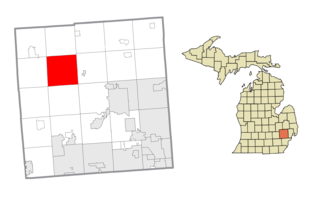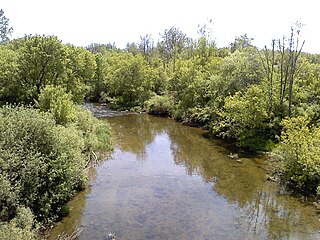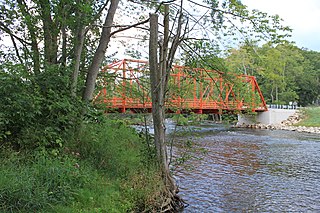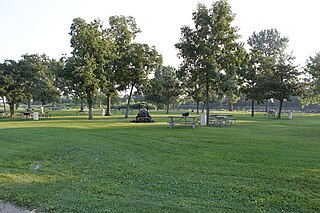
Springfield Charter Township is a charter township of Oakland County in the U.S. state of Michigan. As of the 2010 census, the township population was 13,940. The township was named for the numerous springs in the area.

The Huron River is a 130-mile-long (210 km) river in southeastern Michigan, rising out of the Huron Swamp in Springfield Township in northern Oakland County and flowing into Lake Erie, as it forms the boundary between present-day Wayne and Monroe counties. Thirteen parks, game areas, and recreation areas are associated with the river, which passes through the cities of Dexter, Ann Arbor, Ypsilanti, Belleville, Flat Rock and Rockwood that were developed along its banks.

The Clinton River is a river in southeastern Michigan in the United States. It is named in honor of DeWitt Clinton, who was governor of New York from 1817 to 1823.

The Huron–Clinton Metroparks system is a regional park system in Metro Detroit in the U.S. state of Michigan. The park system includes 13 parks totaling more than 24,000 acres (97 km2) arranged along the Huron River and Clinton River forming a partial ring around the metro area. Plans are in development to finish the ring by building hike/bike trails to connect all the parks as a green belt. The parks draw about 7.5 million visitors a year, down from a peak of 10 million in 2009. The park system is primarily tax-funded with a $50 million annual budget. The system provide employment for 200 full-time and part-time employees year-round and 1,000 additional summer workers. The rivers are prime fishing and canoeing streams with Delhi Metropark including a short rapids, which while runnable, is the only point other than dams on either stream normally portaged.

Stony Creek Metropark is a Huron-Clinton Metropark located in southeast Michigan in the outskirts of metro Detroit. The park is predominantly in Washington Township and Oakland Township, with a small portion in Shelby Township. The park covers 4,461 acres (18.05 km2) with Stony Creek Lake at its center.

Sleepy Hollow State Park is a public recreation area covering 2,678 acres (1,084 ha) in the townships of Ovid and Victor in Clinton County, Michigan. The state park is located off US-127 nine miles southeast of St. Johns and four miles northwest of Laingsburg and centers around man-made, 410-acre (170 ha) Lake Ovid.

Kensington Metropark is a unit of the Huron–Clinton Metroparks system located between Milford and South Lyon, Michigan, USA. The park covers 4,543 acres (18.13 km2). It has wooded hilly terrain and surrounds 1,200-acre (4.9 km2) Kent Lake. The park has an 18-hole regulation golf course, a disc golf course, toboggan hill, a nature center, a farm learning center, picnic areas, beaches, splash pad with water slide and boat rentals. An 8-mile (13 km) paved hike-bike trail, 19 miles (31 km) of horse trails and 7 miles (11 km) of hiking-only trails are available as well as connecting trails to other nearby parks. The only camping is in organized group camping or canoe-in sites. The park receives 2.5 million visitors a year. Kensington Metropark opened in 1947.

Delhi Metropark is a park in the Huron-Clinton system of metro parks. It is a 81-acre (330,000 m2) park on the Huron River located five miles (8 km) northwest of Ann Arbor. It has picnic areas, two picnic shelters, swings and slides, river fishing, canoe rental and softball diamonds. A children's playground features an adventure playship, ride-on toys and swings. A Metropark daily or annual vehicle permit is required for entry to the park. The park will eventually be linked to Dexter-Huron Metropark and Hudson Mills Metropark via the Border-to-Border Trail.

Lake Erie Metropark is a park in the Huron-Clinton system of metro parks. The park is a 1,607-acre (6.50 km2) recreational facility located between the mouth of the Huron River on Lake Erie to the south and the City of Gibraltar to the north, and consists of natural marshes and ponds, hike and bike trails, nature trails, a marina, and a boat launch. The park also has a wave action swimming pool, an 18-hole regulation golf course, and the Marshlands Museum and Nature Center. It has a three-mile (5 km) shoreline along Lake Erie and is a popu bird-watching site. The children's play area, located near the Wave Pool, previously consisted of a child-size city before being reconstructed into a modernized playground.

Oakwoods Metropark is a park in the Huron-Clinton Metroparks system, located along the Huron River near Flat Rock, Michigan. The park consists several miles of bike trails, numerous nature trails, horse trails, a canoe and kayak launch, and a Nature Center. It is directly connected to Willow and Lower Huron Metroparks, as well as Huroc Park through a branch of the Downriver Linked Greenways.

Loon Lake is a freshwater lake located in Waterford Township, Michigan. It borders Dixie Highway on the west and is south of Walton Blvd. on the north. The sand-bottom lake is 243 acres, making it the 18th largest lake in Oakland County, Michigan and one of the largest in Waterford Township.

Elizabeth Lake is a freshwater lake located in Waterford Township, Michigan, along the Clinton River. It connects upstream to 90-acre Crescent Lake and downstream to 1,280-acre Cass Lake.

Silver Lake is a freshwater lake located in Waterford Township, Michigan in Oakland County, Michigan, United States.

Woodhull Lake is a 135-acre all-sports lake located in central Oakland County, Michigan. The lake has a maximum depth of 56 feet. It is located in both Waterford Township and Independence Township.

Oakland Lake is a 255-acre lake located in central Oakland County in both Waterford Township and Independence Township.

Schoolhouse Lake is an all-sports 37-acre lake located in central Oakland County, on the east side of Waterford in Waterford Township.

Leggett Bay is located in Waterford Township, Michigan, United States. The 25-acre bay within Lake Oakland (Michigan) lies north of Walton Blvd. near Clintonville Rd. At its deepest point, the bay is 10 feet deep.

Ford Lake is a fresh water artificial reservoir located in Washtenaw County in the U.S. state of Michigan. The lake was created from the construction of Ford Lake Dam along the Huron River in the early 1930s. The lake is named after business magnate Henry Ford.

The Flat Rock Dam is a decommissioned hydroelectric gravity dam crossing the Huron River. It is located in the city of Flat Rock in Wayne County in the U.S. state of Michigan. The dam was built by the Ford Motor Company in 1924 for hydroelectricity for the nearby Ford Motor Company Lamp Factory, which remained in operation until 1950.

The Superior Dam is a hydroelectric barrage dam crossing the Huron River. It is located in Superior Township in Washtenaw County in the U.S. state of Michigan. It was completed in 1920 and currently provides hydroelectricity to the nearby city of Ann Arbor, which owns and maintains the dam and power station.
















